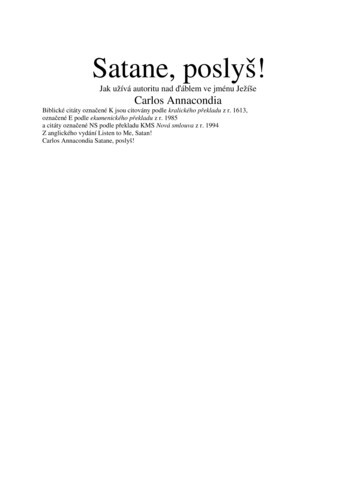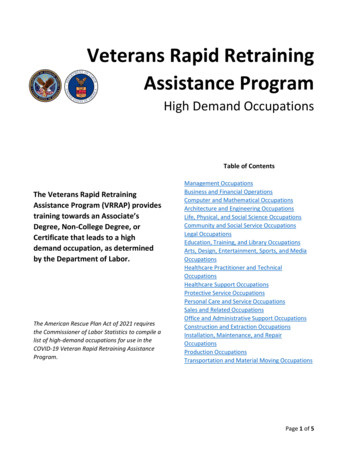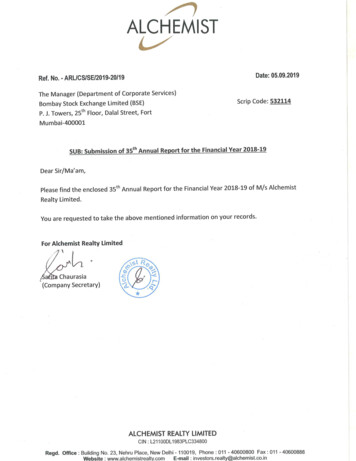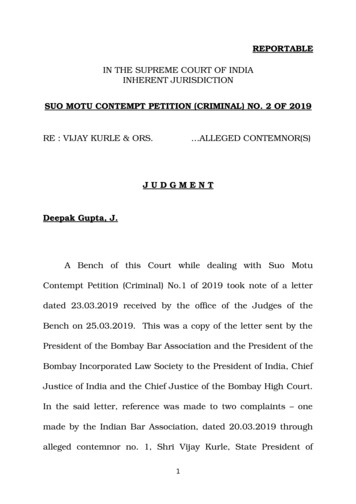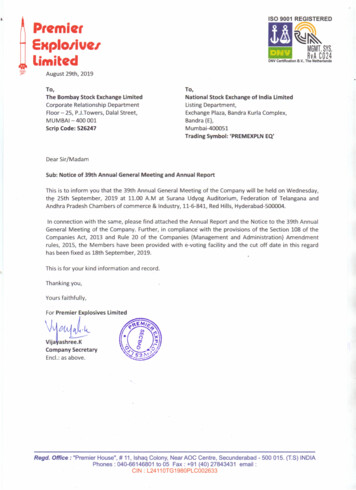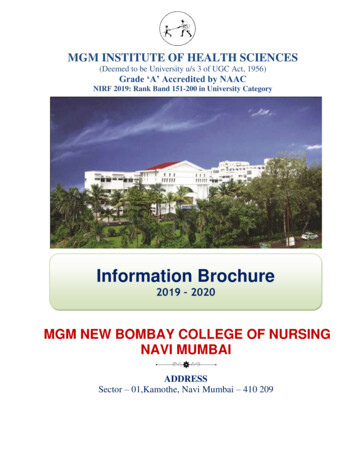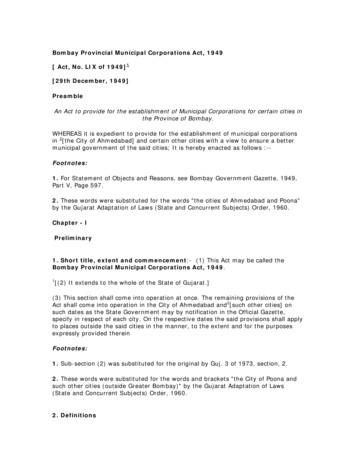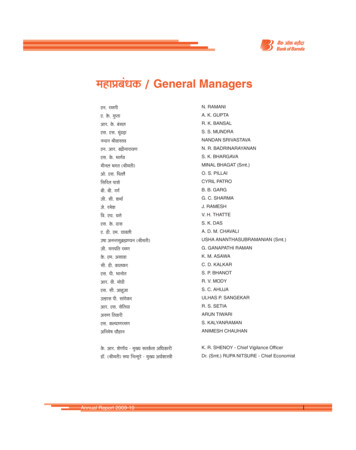
Transcription
ceneØeyebOekeâ / General ManagersSve. jceCeerN. RAMANIS. kesâ. ieghleeA. K. GUPTADeej. kesâ. yebmeueR. K. BANSALSme. Sme. cetboÌ[eS. S. MUNDRAvevove ßeerJeemleJeNANDAN SRIVASTAVASve. Deej. yeõerveejeÙeCeN. R. BADRINARAYANANSme. kesâ. Yeeie&JeS. K. BHARGAVAceerveue Yeiele (ßeerceleer)MINAL BHAGAT (Smt.)Dees. Sme. efheuuewO. S. PILLAIefmeefjue hee eesCYRIL PATROyeer. yeer. ieie&B. B. GARGpeer. meer. Mecee&G. C. SHARMApes. jcesMeJ. RAMESHefJe. SÛe. LeòesV. H. THATTESme. kesâ. oemeS. K. DASS. [er. Sce. ÛeeJeueerA. D. M. CHAVALIG ee DevevlemegyeÇÿeCÙeve (ßeerceleer)USHA ANANTHASUBRAMANIAN (Smt.)peer. ieCeheefle jceCeG. GANAPATHI RAMANkesâ. Sce. DemeeJeeK. M. ASAWAmeer. [er. keâeuekeâjC. D. KALKARSme. heer. YeeveesleS. P. BHANOTDeej. Jeer. ceesoerR. V. MODYSme. meer. DeentpeeS. C. AHUJAGuneme heer. meebieskeâjULHAS P. SANGEKARDeej. Sme. mesefleÙeeR. S. SETIADe Ce efleJeejerARUN TIWARISme. keâuÙeeCejceCeS. KALYANRAMANDeefveces e ÛeewneveANIMESH CHAUHANkesâ. Deej. MesCee@Ùe - cegKÙe meleke&âlee DeefOekeâejerK. R. SHENOY - Chief Vigilance Officer[e@. (ßeerceleer) hee efvelmegjs - cegKÙe DeLe&Meem eerDr. (Smt.) RUPA NITSURE - Chief EconomistAnnual Report 2009-10I
uesKee hejer#ekeâ / AuditorsS. meÛeosJe SC[ kebâ.meveoer uesKeekeâejieghlee veeÙej SC[ kebâ.meveoer uesKeekeâejDeefMJeveer SC[ SmeesefmeSšdmemeveoer uesKeekeâejA. Sachdev & Co.Chartered AccountantsGupta Nayar & Co.Chartered AccountantsAshwani & AssociatesChartered AccountantsSme. kesâ. keâhetj SC[ kebâ.meveoer uesKeekeâejSve. meer. yevepeea SC[ kebâ.meveoer uesKeekeâejnefjYeefòeâ SC[ kebâ.meveoer uesKeekeâejS. K. Kapoor & Co.Chartered AccountantsN. C. Banerjee & Co.Chartered AccountantsHaribhakti & Co.Chartered AccountantsHeÇOeeve keâeÙee&ueÙeyeÌ[ewoe neTme, ceeC[Jeer, JeÌ[esoje 390 006.yeÌ[ewoe keâeHeexjsš mesvšjmeer-26, peer-yuee@keâ, yeevõe-kegâuee& keâe@cHeueskeäme, yeevõe (Het.), cegbyeF& 400 051.efveJesMekeâ mesJeeSb efJeYeeieøeLece leue, yeÌ[ewoe keâeheexjsš meWšj, meer-26, peer-yuee@keâ, yeebõe-kegâuee& keâe@chueskeäme, yeebõe (het), cegbyeF& 400 051.jefpemš ej SJeb DevlejCe SpeWšcewmeme& keâeJeea keâcHÙetšjMesÙej HeÇe. efue. Hueeš veb. 17-24, efJeªuejeJe veiej, Fcespe DemHeleeue kesâ Heeme, ceeOeeHegj, nwojeyeeo 500 081.Head OfficeBaroda House, Mandvi, Vadodara 390 006.Baroda Corporate CentreC-26, G-Block, Bandra-Kurla Complex, Bandra (E), Mumbai 400 051.Investor Services Department1st Floor, Baroda Corporate Centre, C-26, G-Block, Bandra-Kurla Complex, Bandra (E), Mumbai 400 051.Registrars & Transfer AgentM/s. Karvy Computershare Pvt. Ltd. Plot No. 17-24, Vithalrao Nagar, Nr Image Hospital, Madhapur, Hyderabad 500 081.IIJeeef e&keâ efjheesš& 2009-10
efJe eÙe metÛeer / ContentsefJe eÙe metÛeer / Contentshe ‰DeOÙe#eerÙe JekeäleJÙe32efveosMekeâeW keâer efjheesš&35Chairman's Statement2yeemesue II efheuej 3 ØekeâšerkeâjCe59Directors' Report5cenlJehetCe& efJeòeerÙe metÛekeâ74Basel II Pillar 3 disclosures59MeyoeJeueer76Key Financial Indicators74legueve-he e78Glossary76ueeYe-neefve uesKee79Balance Sheet7879Pagevekeâoer-ØeJeen efJeJejCeer121Profit & Loss AccountuesKee hejer#ekeâeW keâer efjheesš&123Statement of Cash Flow121mecesefkeâle efJeòeerÙe efJeJejefCeÙeeb125Auditors' Report123keâeheexjsš ieJeveXme efjheesš&155Consolidated Financial Statements125veesefšme188Report on Corporate Governance155Notice188Øee@keämeer Heâece& / GheefmLeefle heÛeea / F&meerSmeProxy Form / Attendance Slip / ECSAnnual Report 2009-101
CHAIRMAN'S STATEMENTMoving Aheadon SustainablePerformance .M. D. MallyaChairman & Managing DirectorDear Stakeholder,It gives me great pleasure to present the Annual Report andFinancial Statements of Bank of Baroda for the year ended31st March, 2010. The Bank’s business and financialperformance during the year under review has demonstratedits strength and stability amid uncertain economicenvironment.Economic ReviewIndian economic environment was fairly mixed and uncertainduring 2009-10 (FY10). The first half of the year (i.e., H1,FY10) was overcast by the monsoon failure and a sharpdecline in foodgrain production, a continued slowdown infinal consumption expenditure, a muted demand for bankcredit and a negative growth in both exports and imports.However in the second half of 2009-10 (i.e., H2, FY10),countercyclical policies, a pickup in the global economy anda recovery in capital inflows helped India overcome anadverse monsoon and see a quick rebound in the economy.Both exports and imports turned positive by NovemberDecember, 2009 after contracting continuously for theprevious 12-13 months.The headline inflation (WPI), after remaining subdued duringH1, FY10 increased at a faster pace in H2, FY10 and cameclose to 10.0% (y-o-y) in March, 2010. At the same time,driven by manufacturing and mining sectors, the industrialproduction recovered from 1.1% (y-o-y) in April, 2009 to15.1% (y-o-y) in February, 2010. Rapid growth in bothinflation and industrial production has prompted the ReserveBank of India (RBI) to normalise its Monetary Policy andmove its focus to “recovery management” from the earlierthrust on “crisis management”.2While the demand for bank credit remained highly subduedand skewed throughout the year under review, credit costsincreased for several banks with the maturing of restructuredloans. Moreover, higher level of government marketborrowings and resultant volatility in bond yields posed toughchallenges for the banking industry’s treasury operations.Bank of Baroda’s Resilience to ShocksWhile it is challenging to remain immune to the disruptionscreated by economic shocks, Bank of Baroda has been ableto withstand the turbulence more effectively during FY09and FY10 mainly due to its strong business fundamentals.Again in the year FY10, the Bank could demonstrateconsistent performance by delivering much better quality ofearnings, healthier asset quality compared to bankingindustry with higher provision coverage and lower interestrate risk. It has been steadily improving its market sharealso. It expanded its global business level by 24.0% (y-o-y)to Rs 4,16,080 crore during the year FY10.Despite ongoing global economic challenges, the Bank’sinternational operations continued to remain its mainstayand contributed almost 24.0% to the Bank’s total businessand 20.0% to its operating profits in FY10. The Bank’sinternational business grew by 31.0% (y-o-y) in FY10 withoutany compromise with credit quality. The Bank’s gross NPAin international operations stood at 0.47% and net NPA atjust 0.11% in FY10.One of the greatest strengths of the Bank over a period oftime has been the “trust and confidence” that it enjoys of itsstakeholders. Notwithstanding the unprecedented turbulentconditions created by the global economic meltdown duringthe years FY09 and FY10, the Bank’s stakeholders remainedJeeef e&keâ efjheesš& 2009-10
Chairman's Statementfirmly positive on the Bank’s business and financialperformance. I am happy to share with you that the Banktoo met the stakeholders’ expectations in terms ofperformance, transparency, corporate governance andintegrity in guidance during the last couple of years.New InitiativesDuring the year under review, the Bank maintained its focuson introducing new business, customer and technologyinitiatives to further strengthen its operations and leverageits considerable domestic footprint.The Bank launched a new business process reengineeringand organisational restructuring project “NavnirmaanBaroda Next” on 22nd June, 2009. The project envisagesredesigning and streamlining of existing processes andstructures including revamp of the branch architecture forbetter service and sales, higher revenue growth andimproved efficiency. The project is primarily designed tooptimise on available resources to maximise business andprofits and to build a next step for Bank of Baroda, that is,“Baroda Next.”The Bank achieved 100.0% Core Banking Solution (CBS)for all its domestic branches reflecting the fastest ever rollout of such solutions in the Indian banking industry. TheBank’s CBS branches are enabled for inter-bank remittancesthrough the RTGS and NEFT. Around 94.0% of its overseasbusiness is also covered under the CBS.By 31st March 2010, the Bank’s ATM network expanded to1,315. Moreover, “Base 24” has been made fully operationalfor all domestic ATMs and for ATMs in the Bank’s sevenoverseas territories. Today, the Bank’s customers enjoymultiple service channels like Baroda Connect (InternetBanking), Phone Banking, Baroda Cash ManagementServices, NRI Services, Depository Services, etc.The Bank has implemented an Integrated Global TreasurySolution in its major overseas territories. It has also startedproviding Online Institutional Trading to its corporatecustomers. During FY10, many other important technologicalinitiatives were taken in the domain of anti-money laundering,document management system, payment messagingsolution, etc.In order to improve credit flows under the retail businessand to consolidate that portfolio, the Bank has realigned itsretail bouquet of products. The Bank has also launched anew subsidy-linked housing loan scheme under the HomeLoan Product styled as “Interest Subsidy Scheme forHousing the Urban Poor.”A couple of years ago, the Bank introduced a Retail LoanFactory model as a fast delivery channel for the benefit ofits retail customers. Going by the success of this initiative,the Bank opened six new Retail Loan Factories during FY10,taking the total number of such factories to 30.Leveraging its newly created robust technological platform,the Bank made “Home Loan and Education Loan ApplicationModules” online during the year under review.Annual Report 2009-10The Bank has always believed in making a difference to thesociety at large. The Bank took several initiatives on the“Financial Inclusion” front during FY10 to harness theemerging opportunities for rural and agriculture lending. Toaugment its Agriculture advances, the Bank conductedspecial campaigns for Crop Loans and Investment Credit.The Bank organized 2,857 Village Level Credit Camps anddisbursed Rs 2,484 crore to over 1.9 lakh borrowers duringFY10. The Bank identified 450 thrust branches across Indiato enhance agricultural lending. The Bank formulatedvarious area-specific agricultural lending schemes withvarious concessions in the rate of interest, charges, etc., inthe interest of poor farmers.Towards the effective use of technology in rural agriculturallending, the Bank has introduced IT-enabled smart cardbased technology for financial inclusion. With nine additionalBaroda Swarojgar Vikas Sansthan (Baroda R-SETI) Centresopened during FY10, the total number of BSVS has goneup to 25. Over two million no-frill savings accounts havebeen opened so far. As part of the Financial InclusionInitiative, the Bank has opened four Financial Literacy andCredit Counselling Centres (FLCCs) christened as“SARTHEE”.Adding its offerings in wealth management products, theBank has entered into tie-up arrangements with two moreleading asset management companies in FY10 fordistribution of mutual fund products. The Bank’s joint venturein life insurance, in association with Andhra Bank and L &G (U.K.) – IndiaFirst Life Insurance Co. Ltd. commenced itsoperation during the year. The IndiaFirst has received anoverwhelming response from the Bank’s customers acrossthe country, making the company the fastest growingInsurance company to reach Rs 100 crore premiumcollections in the first 100 days of its launch.Business & Financial PerformanceThe Bank has reported a healthy growth in its business andprofits with improvement in all key parameters duringFY10.As stated earlier, its Global Business touched a newmilestone of Rs 4,16,080 crore in FY10 reflecting a growthof 24.0% (y-o-y). Both its domestic deposits and advancesincreased at the above-industry pace of 22.4% and 21.3%,respectively. The Bank’s domestic low-cost or CASAdeposits grew by an unprecedented 25.1% taking the shareof domestic CASA deposits to 35.63% in FY10 versus34.87% in FY09. Its Social Sector Advances or PrioritySector Credit surpassed the mandatory requirement andposted a growth of 24.0% (y-o-y). The Bank recorded agrowth of 44.0% in SME credit, 27.0% in farm credit and24.0% in retail credit reflecting a well-diversified growthachievement.In its overseas business, while the Bank’s deposits grew by36.0% (y-o-y), its advances grew by 25.0% during FY10.Within total overseas deposits, the customer deposits grewby 33.7%. Total assets of the Bank’s overseas operations3
Chairman's Statementincreased from Rs 51,165 crore to Rs 68,375 crore registeringa growth of 33.6% during the year under review.The growth in profits was led by healthy topline growth,prudent management of deposit costs and better operatingefficiency. The Bank’s Net Profit at Rs 3,058.33 crore forFY10 reflected a robust year-on-year growth of 37.3%.As the Bank’s primary objective has been to grow withquality, the Bank focused on containing the impaired assetsto the minimum possible level. While the Gross NPA indomestic operations stood at 1.64% at end-March 2010, thesame for Overseas Operations was at 0.47%. In spite ofgrowing slippages for Indian banking industry during FY10,our Bank succeeded in restricting its global Gross NPA levelto 1.36% and Net NPA level to 0.34% by end-March, FY10.While the RBI has extended the deadline for recovery fromthe Agricultural Debt Relief accounts till end-June, 2010,the Bank has continued to classify these accounts as NPAas a prudent measure. Despite this, the Bank enjoys one ofthe lowest ratios for Gross and Net NPA in the industry. TheBank’s NPA coverage ratio at 74.90% as on 31st March,2010 has been comfortably above the norm of 70.0% setrecently by the RBI.The Bank’s Return on Average Assets (ROAA) at 1.21%,Earnings per Share (EPS) at Rs 83.96, Book Value perShare (BVPS) at Rs 378.40, and ROE (Return on Equity)at 22.19% reflect a significant improvement over theirprevious year’s levels. The Bank’s Capital Adequacy Ratiotoo stood at the healthy level of 14.36% with the Tier 1 capitalat 9.20% during FY10. The Bank’s Cost-Income ratio alsoeased from 45.38% to 43.57% on year-on-year basis.Looking ForwardBank of Baroda’s long standing reputation for financialsoundness, long-term customer relationships and proactivemanagement are as important today as ever. Going forwardalso, the Bank would continue with its thrust on growth withquality. At the same time, it would try to grow above theindustry average on the back of strongly positive growthoutlook for India in FY11.The Bank would try to protect or improve further the currentlevels of its key financials like ROAA, ROE, EPS, BVPS,asset quality, etc., through its dedicated focus on low-costdeposit mobilization & fee-based income, efficient pricingof deposits and loans, reduction in high cost or low yieldingbulk business and through improved credit origination andeffective credit monitoring.In all core operations, the Bank has put in place strategiesthat seek to address near-term challenges as well as toseize opportunities to strengthen its foundations forsustainable growth. The focus of these strategies has beenon well-balanced, qualitative growth, service and operationalexcellence and people management.In fact, the Bank has been aggressively recruiting the best4possible talent in the country from the premier Institutionsduring the last couple of years. The Bank has been workingon the business process reengineering (BPR) project inconsultation with the Mckinsey & Co. so as to achieve theoptimum use of technology and right skilling of the manpowerto yield maximum customer satisfaction. During FY10, theBank also launched a series of marketing campaigns topromote its brand value. The same would continue in futurealso, in order to strengthen the Bank’s market share bothfrom the asset and liablity sides.The Bank has been actively designing strategies forenhancing sales and raising brand equity through continuousmarket research. The Bank has also focused on evolving aStrategic Mass Communication and Events Plan to ensurebrand enhancement. Besides this, significant initiatives incustomer education would continue for putting in place aneffective Customer Relationship Management system in theBank.Bank’s Corporate Goals & StrategyFor the year 2010-11, the Bank has selected the motto“Leveraging technology for augmenting business growthand profitability.”The ultimate objective of the Top Management of the Bankis to equip the Bank with more stability and growthorientation. To attain this goal, we have adopted a BusinessModel that focuses on achieving sustainable growth. Thismodel has four pillars – Healthy CASA, Well-diversifiedAdvances Portfolio, Strong back up of Non-interest incomeand Stringent NPA Management. The Bank is well gearedto ensure that its performance will be driven across all theseparameters.The Bank is aware of the fact that the market leadershipcan be achieved only through a visionary, strategic andsustainable model of pursuit and perseverance. The successlies in attaining the acceptance of our stakeholders aboutthe Bank’s core values, passion for customer service andthe credibility of leaders, which alone would give our Banka unique place in the banking space. In a bid to gain bettermarket share, we will work relentlessly to provide financialstability and brand value that matters the most.It will be our endeavour in FY11 to work towards morecustomer-centricity by upgrading our institutional processes,systems and capabilities. In the current economic environment,prudence and proactive vigilance are most important toconvert challenges into opportunities. So, our central focuswill be on risk management and growth with quality.In our pursuit to move towards the top position in the industry,I solicit your continued cooperation and patronage.M. D. MallyaChairman & Managing DirectorJeeef e&keâ efjheesš& 2009-10
DIRECTORS’ REPORTYour Directors have pleasure in presenting the One Hundredand Second Annual Report of the Bank with the audited BalanceSheet, Profit & Loss Account and the Report on Business andOperations for the year ended March 31, 2010 (FY10).Performance Highlights Total Business (Deposit Advances) increased to Rs4,16,080 crore reflecting a growth of 24.0%. Gross Profit and Net Profit were Rs 4,935 crore andRs 3,058 crore respectively. Net Profit registered a growthof 37.3% over previous year. Credit-Deposit Ratio stood at 84.55% as against 81.94%last year. Retail Credit posted a growth of 23.5% constituting18.15% of the Bank’s Gross Domestic Credit in FY10. Net Interest Margin (NIM) in global operations as percent of interest earning assets was at the level of 2.74%and in domestic operations at 3.12%. Net NPAs to Net Advances stood at 0.34% this yearagainst 0.31% last year. Capital Adequacy Ratio (CAR) as per Basel I stood at12.84% and as per Basel II at 14.36%. Net Worth improved to Rs 13,785.14 crore registering arise of 20.6%. Book Value improved from Rs 313.82 to Rs 378.44 onyear. Business per Employee moved up from Rs 911 lakh toRs 1,068 lakh on year.Segment-Wise PerformanceThe Segment Results for the year 2009-10 (FY10) reveal thatthe contribution of Treasury Operations was Rs 1,048 crore,that of Corporate/Wholesale Banking was Rs 1,585 crore,that of Retail Banking was Rs 779 crore, and of Other BankingOperations was Rs 2,732 crore. The Bank earned a Profit afterTax (PAT) of Rs 3,058 crore after deducting Rs 1,906 crore ofunallocated expenditure and Rs 1,180 crore towards provisionfor tax.DividendThe Bank’s Directors have proposed a dividend of Rs 15/- pershare (on the face value of Rs 10/-per share) for the yearended March 31st, 2010. The total outgo in the form of dividend,including taxes, will be Rs 639.26 crore.Capital Adequacy Ratio (CAR)The Bank’s Capital Adequacy Ratio (CAR) is comfortable at14.36% under Basel II as on 31st March 2010. During the year,the Bank strengthened its capital-base by raising Rs 1,000crore through unsecured subordinated bonds and Rs 900 crorethrough innovative perpetual bonds.The Bank’s Net Worth as at 31st March 2010 was Rs 13,785.14crore comprising paid-up equity capital of Rs 365.53 crore andreserves (excluding revaluation reserves) of Rs 13,419.61crore. An amount of Rs 2,419.07 crore was transferred toreserves from the profits earned.Other Prudential MeasuresAs a prudent measure, the Bank has made provision towardscontribution to gratuity (Rs 131.93 crore), pension funds(Rs 120.21 crore), leave encashment (Rs 134.29 crore) andadditional retirement benefits (Rs 16.28 crore) on actuarialbasis. Total provisions under these four categories amountedto Rs 402.71 crore during the year 2009-10, against Rs550.60 crore during 2008-09. Total corpus available with theKey Financial 1,71,666.554.985.812,16,735.541,75,818.59Average Yield (%)7.708.58Net Interest Margin (%)2.742.91Cost-Income Ratio (%)43.5745.38378.44313.8283.9661.14Return on Average Assets (ROAA) (%)Average Interest Bearing Liabilities (Rs crore)Average Cost of Funds (%)Average Interest Earning Assets (Rs crore)Book Value per Share (Rs)EPS (Rs)Annual Report 2009-105
Directors' ReportBank at the end of March 2010 under these heads is: Rs 948.54crore (gratuity), Rs 2,835.10 crore (pension funds), Rs 488.31crore (leave encashment), and Rs 340.56 crore (additionalretirement benefits).Management Discussion and AnalysisEconomic Scenario in 2009-10Indian economy strongly rebounded during the year FY10ahead of most countries in the world, thanks to the timelymonetary easing and strong fiscal stimulus provided by theReserve Bank of India (RBI) and the Central Government,respectively, in the wake of the global crisis. Other factors thatfacilitated its bounce-back during FY10 were an improvingglobal economy, a return of risk appetite in financial marketsand large capital inflows.Moreover, India was not at the centre of the crisis and its growthis largely dependent on domestic drivers. So, the global crisiscould not dent the country’s medium-term growth potential.The Government’s advance estimates for the year have putIndia’s real GDP growth at 7.2% for FY10 reflecting a markedimprovement over the 6.7% recorded in FY09. The maincontributors to this growth have been manufacturing (8.9%),mining & quarrying (8.7%) and the services sector (8.8%).Agriculture output, however, is estimated to have fallen by0.2% as against a growth of 1.6% in FY09 reflecting the poorSouth-West monsoon rains. According to the Governmentreports, production of foodgrains and oilseeds is likely to havedeclined by 8.0% and 5.0%, respectively, on year on yearbasis. However, the adverse impact of sub-normal monsoonhas been contained to a large extent by a better-than-expectedrabi (winter) crop in FY10.Within the manufacturing sector, the industries like infrastructure,cement, steel, automobiles, machinery & equipment, transportequipment, rubber, plastic & chemical products, etc., havegrown strongly during FY10. However, sectors like consumernon-durables, power generation and labour intensive exportoriented industries like textiles, gems & jewellery, etc., continuedto remain fragile.The expansion of services sector was healthier at 8.8% in FY10.However, it slowed down from a year earlier due to a moderatepace of spending by the Government on compensation toemployees.Final consumption expenditure too remained subduedduring FY10, as growth in both private and Government finalconsumption expenditure slowed down. However, investmentdemand, especially gross fixed capital formation showed agradual recovery during the year.The Wholesale Price Index (WPI) inflation, after remainingsignificantly subdued during the first half of FY10, increasedat a faster pace in the second half and reached 9.9% byMarch, 2010. While a significant portion of inflation could beexplained by a shortfall in agricultural production and spikesin international crude oil prices, indications of generalization ofinflation became increasingly evident starting from November2009. Inflation in non-food manufactured products increasedfrom (-) 0.4% in November 2009 to 4.7% in March 2010.6A rebound in the economy and rising inflation pressuresprompted the RBI to signal the beginning of an exit from its crisispolicy stance since October 2009 when it restored the StatutoryLiquidity Ratio (SLR) to 25.0% and tightened provisioningrequirements for property loans. Subsequently, it raised theCash Reserve Ratio (CRR) by 75 bps to 5.75% in late January,2010. Again, it raised the Repo and Reverse Repo Rates by 25bps each on March 19th 2010 ahead of the Annual MonetaryPolicy in April, 2010 to guard against inflationary expectationsbecoming entrenched. This was the first change in policy ratessince April 2009.A strong revival in global demand brought back India’s exportgrowth to a positive zone in November 2009 after 13 months ofyear-on-year declines. Imports too moved to positive growth inDecember 2009 after 12 months of year on year contraction. Incumulative terms, however, exports declined by 11.3% (y-o-y)in Apr-Feb, FY10, while imports declined by 13.5%. The tradedeficit during the first eleven months of FY10 stood at US 95.42billion as against US 114.72 in the corresponding period ofFY09. The robust growth in invisible receipts observed duringthe past few years was reversed in FY10 due to the laggedimpact of recession in advanced economies. Despite lowertrade deficit, the fall in invisibles surplus led to marginally highercurrent account deficit during FY10. The latest available datashow that the current account deficit during April-December,2009 stood at US 30.3 billion, higher than US 27.5 billionduring April-December, 2008.A noteworthy feature of economic revival during FY10 was theresumption of large capital inflows led by both the FII and FDIinflows. According to the RBI Report, the FII (net) investmentin India during FY10 was US 29 billion while FDI inflowsamounted to US 33.1 billion during April-February, FY10. Innominal terms, the rupee appreciated against the US Dollarby 11.5% during FY10 primarily due to an upsurge in capitalinflows. However, an increase in inflation differentials betweenIndia and its trading partners during the year resulted in muchhigher appreciation of real exchange rate.During FY10, India’s foreign exchange reserves (FER)increased by US 27.1 billion to reach US 279.1 billion as atend-March 2010. Furthermore, the RBI purchased 200 metrictonnes of gold from the IMF on November 3, 2009 as part ofthe RBI’s FER management operations.India’s external debt stock at US 251.4 billion at end-December2009 recorded an increase of US 26.8 billion over its level atMarch 2009 primarily on account of an increase in long-termdebt.Indian equity markets displayed vibrancy and increasedmomentum during FY10 except for some occasional correctionscaused by Dubai World default and the Greek sovereign debtconcerns during the last two quarters of FY10. On the whole,the benchmark indices Sensex and the Nifty gained 81.0%and 74.0% respectively, on year-on-year basis, primarily onthe back of huge FII inflows.The Central Government’s fiscal deficit for FY10 is expectedto remain within the 6.8% of GDP target. Stronger divestmentreceipts and direct tax revenue could make up for the shortfall,if any, in 3G auction proceeds and indirect tax collections,Jeeef e&keâ efjheesš& 2009-10
Directors' Reportwhile higher than budgeted spending on pensions and food &fertilizer subsidies can be accommodated through savings onother accounts.The Government’s record market borrowings programmeproceeded well and in a non-disruptive manner during FY10with limited impact on bond yields.The Union Budget for FY11 has set the goal of reducing thefiscal deficit to 5.5% of GDP in FY11 and further to 4.8% in FY12and to 4.1% in FY13. This will be facilitated by the expectedfall in expenditure items and likely revenue buoyancy, goingforward.The Union Budget for FY11 began the exit from fiscal stimulusby partially rolling back some of the duty relaxations introducedduring the crisis period. It hiked the excise duty from 8.0%to 10.0%. The other tax proposals included rationalizationof income tax slabs, additional excise duty on petrol &diesel, and a restoration of 5.0% customs duty on petroleumproducts, including crude oil. A landmark reform in the areaof government subsidy is the introduction of nutrient-basedsubsidy for fertilizers. This policy is expected to improveagricultural productivity, contain the subsidy bill over time andoffer environmental benefits. Furthermore, the governmenthas decided not to issue any more special off-budget bondsfrom FY11 to finance subsidies for fuel, food and fertlisers.Another major fiscal development is a revival programme forthe disinvestment of state-owned enterprises listed on the stockexchanges. During FY10, the government raised a record Rs33,500 crore through this route, whereas the FY11 Budget callsfor realisation of Rs 40,000 crore through disinvestment.The outlook for India, going forward, looks strongly positive.Its economy has been showing steady improvement. Industrialrecovery is expected to take firmer hold on the back of risingdomestic and external demand. Exports and imports havebounced back since October-November, 2009. Flows of fundsto the commercial sector from both bank and non-bank sourceshave picked up. Business outlook surveys by the RBI andother agencies suggest that business optimism has improved.On balance, under the assumption of normal monsoon andsustained good performance of the industrial and servicessectors, the RBI has projected real GDP growth for India forFY11 at 8.0% with an upside bias.Performance of Indian Banking Sector in FY10Indian banking industry stood firm and resilient amid the globalcrisis on the back of its improved productivity since the mid1990s and a robust regulatory and supervisory framework.The Industry’s financial soundness indicators rema
The Bank achieved 100.0% Core Banking Solution (CBS) for all its domestic branches reflecting the fastest ever roll out of such solutions in the Indian banking industry. The Bank's CBS branches are enabled for inter-bank remittances through the RTGS and NEFT. Around 94.0% of its overseas business is also covered under the CBS.
